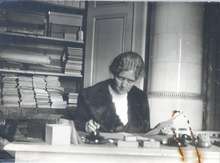Naima Sahlbom
| Naima Sahlbom | |
|---|---|
 | |
| Born |
15 May 1871 Stockholm |
| Died |
29 March 1957 (aged 85) Stockholm |
| Nationality | Swedish |
| Fields | Chemistry, mineralogy |
| Alma mater | |
| Thesis | Kapillaranalyse kolloider Lösungen (Capillary analysis of colloidal solutions) (1910) |
| Doctoral advisor | Friedrich Fichter |
| Notable awards | Illis Quorum (1946) |
Naima Sahlbom (15 May 1871 – 29 March 1957) was a Swedish chemist, mineralogist, and peace activist. She is considered to be one of Sweden's most notable women chemists of the late 19th and early 20th century.[1]
Early life and education
Sahlbom was born in Stockholm, Sweden, on 15 May 1871. She was the daughter of Charlotte Sahlbom (née Hallin) and Gustav Valfrid Sahlbom, a civil engineer. As a youth, she attended the Wallinska Girls' School, Sweden's first educational institution to offer university-preparatory education for girls. Scientifically-inclined, Sahlbom was arranged by her father to volunteer at Stockholm Water's laboratory, and she obtained her primary lab experience. In 1893 Sahlbom passed her matriculation examinations and attended Stockholm Högskola (now Stockholm University), where she gained experience in the analysis of minerals. Nominated by Helge Bäckström, Sahlbom was inducted as a member of the Geological Society of Stockholm on 10 May 1894. In 1894 she attended Uppsala University, majoring in geology and graduating in 1896.[1][2][3][4]
Scientific research
In 1897 Sahlbom published her first scholarly paper, and the findings detailed a mineral analysis of rocks collected on the island of Alnön. In 1900 Johan Gunnar Andersson of Uppsala University and Sahlbom published a collaborated study on the fluoride content in Swedish phosphorites.[1] The paper noted a similarity in the chemical composition of fluorapatite mineral between two marine invertebrates: the Obolid brachiopod fossil and the Lingula anatina.[5] For financial purposes, Sahlbom declined a research opportunity from Arvid Högbom of Uppsala University and accepted a job offer by John Landin to work at a chemical engineering company in Stockholm. Subsequently, from 1902 to 1903, she was employed at the Geological Survey of Finland in Helsinki, where she was the first woman to be initiated in the Finnish Chemical Society. Due to her association with Hjalmar Sjögren, the former professor of mineralogy and geology at Uppsala University and then director of the mineralogy department at the Swedish Museum of Natural History, Sahlbom extended her experience on mineral analysis by operating at the mineralogy department of the Swedish Museum of Natural History.[3]
During 1903 and 1904, English scientists published research about radioactivity in the scientific journal Nature. In the first 1904 issue, R. J. Strutt identified that radium was detected in the gases of Bath springs. In the next issue, Baron Blythswood and H. S. Allen reported evidence of radioactive gases in Buxton mineral springs. Based on the findings, Sjögren recommended Sahlbom to analyze radioactivity in Swedish waters and referred her to Alexander Classen in Aachen. In 1904 Sahlbom was a pupil of Classen and reviewed radioactive techniques. In 1905 the initial iron springs she tested produced data that deviated, including among adjacent springs. In 1906, advocated by spas, she continued to analyze springs in central and southern Sweden. Her findings demonstrated a lack of correlation between the chemical composition of water resources and radioactivity as well as the depth of wells and radioactivity. A correlation between the geology of water resources and radioactivity was exhibited. Sandstone bedrock in Helsingborg and wells in granite displayed among the highest concentrations of radioactive gases. Sahlbom derived that water resources amassed radioactive gases from flowing through bedrock that contained radium. In 1907 Sahlbom and Sjögren published a paper on 59 springs and wells in Sweden. The paper supported evidence of radioactive emanation in mineral waters.[3][4][6]
In the fall of 1907, Sahlbom was admitted to the University of Basel. To proceed with her studies, she declined a research offer from Sjögren.[3] Advised by Friedrich Fichter from the University of Basel, Sahlbom completed her thesis. In 1910 she presented her work at the University of Neuchâtel, and earned a doctorate in chemical physics.[1]
In 1914, with input from Helge Backlund, Sahlbom set up a laboratory in Stockholm, where she specialized in aqueous mineralogy.[2]
Personal life
From 1919 to 1944, Sahlbom was a board member of the Swedish division of the Women's International League for Peace and Freedom (WILPF). She was appointed as the section president of Sweden's WILPF in 1935 and was awarded the Illis Quorum medal in 1946.[2][7]
At the age of 85, Sahlbom passed away in a Stockholm retirement facility on 29 March 1957.[1]
References
- 1 2 3 4 5 Creese, Mary R. S.; Creese, Thomas M. (2004). Ladies in the Laboratory II. Scarecrow Press. p. 8. ISBN 978-0-8108-4979-2.
- 1 2 3 Creese, Mary R. S. (2007). "Fossil hunters, a cave explorer and a rock analyst: notes on some early women contributors to geology". In Burek, Cynthia V.; Higgs, Bettie. The Role of Women in the History of Geology. London: Geological Society of London. p. 44. ISBN 978-1-86239-227-4.
- 1 2 3 4 "Naima Sahlbom - Svenskt Biografiskt Lexikon". sok.riksarkivet.se. Retrieved 2016-12-04.
- 1 2 Svensson, Chester (2013). Howden, Nicholas; Mather, John, eds. History of Hydrogeology. London: CRC Press. p. 329. ISBN 9780415630627.
- ↑ Purra, Ivar; Nemliher, Jüri (2001). Brunton, C. Howard C.; Cocks, L. Robin M.; Long, Sarah L., eds. Brachiopods: Past and Present. London: CRC Press. p. 12. ISBN 9780203210437.
- ↑ Science Abstracts: Physics. VII. London: E. & F. N. Spon. 1904. p. 228.
- ↑ Andersson, I. (2003). "`Women's Unarmed Uprising Against War': A Swedish Peace Protest in 1935". Journal of Peace Research. 40 (4): 395–412. doi:10.1177/00223433030404003. ISSN 0022-3433.